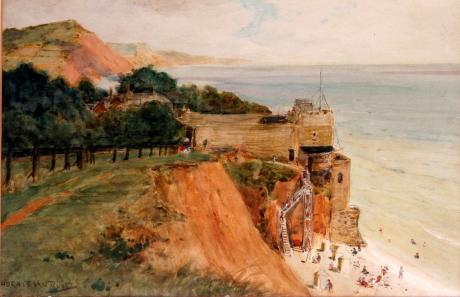signed and further inscribed on the reverse
Jacob’s Ladder itself is the tall white set of steps that have been constructed to link the Gardens to the beach below. This is not, however, the first structure in this location. An access in this area actually dates back to the mid 19th Century when steps were cut into the cliff to give access to the beach below which had been largely inaccessible until then. This developed into a cart track that was used to transport lime (brought in by boat from places such as Branscombe) to the lime kiln which has now been converted into the Tea Rooms. The ongoing cliff erosion caused the path to fall in 1870 but access to the beach had become so popular with the Victorian population by this time that an extremely long ladder was built, like Jacob’s ladder to heaven, hence its name. The steep ladder was not popular though, being difficult to use in the dress of the day, and so a new ladder was constructed in much the same style as the steps of today. The chine with the zig-zag path down to the beach was not created until the 1950’s, the esplanade walk around the base of the cliff being completed a few years later. Jacob's Ladder starts from Connaught Gardens and then zig zags down to the beach. The gardens were named after His Grace, The Duke of Connaught, Queen Victoria’s third son. Although the Duke’s first visit to Sidmouth was not until 1931, the Royal link with Sidmouth continues back over a century earlier when the young Princess Victoria, aged only 6 months, visited with her parents and stayed in what is now the Royal Glen Hotel. It was the Duke himself who formally opened the Gardens on 3rd November 1934 at the age of 84. The plaque marking this grand opening is still clearly visible within the Gardens overlooking the main lawn.
Born in Capri in 1839, Horace van Ruith built his career as a professional painter who specialized in portraiture, landscapes and genre scenes in oil and watercolour. He had addresses in Capri, London and Bombay and is best known for his landscape and genre paintings of India and Capri. He visited Bombay sometime between 1879 and 1884 and is known to have established a studio in the city. He painted a number of portraits of local people, especially those engaged in various trades: coolies at work, cotton cleaners, cord makers and street musicians. He often identified his Indian sitters by naming them on the painting as in the present lot. Van Ruith participated in the Colonial and Indian Exhibition of 1886, held in London, where he exhibited a number of these paintings. Queen Victoria's son, the Duke of Connaught, commented of his work, "no man understands the peculiar characteristics of Indian life better than he does and he is a very clever artist." This is evidenced in the present portrait which skilfully captures the innocence of the young sitter. Van Ruith visited India again, probably around 1900, and worked in Baroda at the invitation of His Highness the Gaekwad of Baroda, joining the ranks of other British born artists such as Tilly Kettle, James Wells, Thomas Hickey and Robert Home, who were also working on commissions from various Royal courts in India. Despite his long life and obviously considerable output, van Ruith's pictures are rare today.



